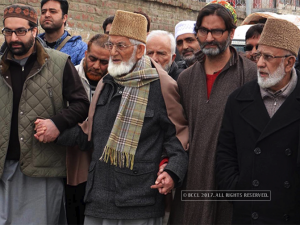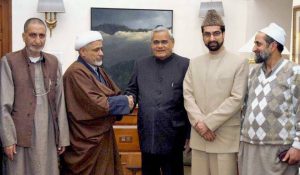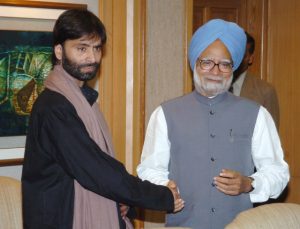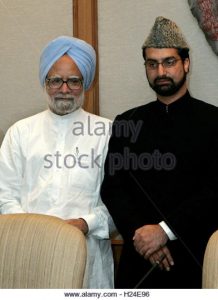Peace Watch » Editor's Take, Kashmir-Talk, Point of view » Indian Prime Ministers: Hurriyat Is Credible Party?
Indian Prime Ministers: Hurriyat Is Credible Party?
New Delhi and the Hurriyat
The relationship has got more complicated than ever
Z. G. Muhammad
New Delhi’s present attitude towards the Hurriyat, particularly after 2016 has been unjust. (In this column, the Hurriyat clubs all the resistance organisation that in 1993 where its constituents). In 24 years history of relations between the Hurriyat and New Delhi, it has not always been so. The two have had a love hate relationships. Let me use a more appropriate phrase; the two have had a ‘roller-coaster relationship’- with all its ups and downs, unexpected twists and turns- there have been periods of screams and moments of cheers – that on occasions had spawned hope of a turnaround in the state. To understand the complex relationship with all its nuances and niceties between New Delhi and the Hurriyat, one needs to look into its genesis and history of engagements between the two, behind the scene and on the track one.
organisation that in 1993 where its constituents). In 24 years history of relations between the Hurriyat and New Delhi, it has not always been so. The two have had a love hate relationships. Let me use a more appropriate phrase; the two have had a ‘roller-coaster relationship’- with all its ups and downs, unexpected twists and turns- there have been periods of screams and moments of cheers – that on occasions had spawned hope of a turnaround in the state. To understand the complex relationship with all its nuances and niceties between New Delhi and the Hurriyat, one needs to look into its genesis and history of engagements between the two, behind the scene and on the track one.
The year 1989, in the contemporary history, was cataclysmic in as much as it brought about abrupt political changes with big bangs in the state. It not only uprooted the traditional political parties and leadership but also buried the ‘dominant discourses’ that have had sway for a decade and a half in the State. The ‘guerrilla revolt’ launched by a group of young men had ‘stunningly’ generated a popular response, and there were huge mass rallies in support of Azadi almost all over the state. The intense public support had not only changed the ground realities as the obtained in 1989 but also changed global perceptions about Kashmir. Carnegie Endowment For International Peace in one of its publication in 1995 wrote: “Before 1989, India and Pakistan fought over Kashmir. Since late 1989, it is the Kashmiris who have done much of the fighting – and most of dying.” In 1993, there was a paradigm shift in the US, Kashmir policy it reiterated its stand for holding a plebiscite in the State under the aegis of the United Nations- something it had not done after 1962 China War. Despite, New Delhi’s resentment to the statements of Rabin Raphel, President Clinton’s publicly expressed American dissatisfaction with India’s human rights record in Kashmir. ‘The guerilla war rapidly intensified because of response to New Delhi’s oppression (Kashmir- Roots of Conflict Sumntra Bose p 3), and it also became the cause of worry for the establishment. Some analysts and think tanks drawing a parallel between Kashmir and guerrilla wars in other parts of the world saw something near to Évian Accords on cards. Moreover, they started looking for an interface for initiating a dialogue with boys on the ground and political leadership and ending militancy in the state. To achieve this objective besides officers from various agencies, many activists and journalists from O.P. Shah to Kuldip Nayer to Prof A. M. Khusro frequented Srinagar. Despite, New Delhi using ‘hard and soft options, it saw no light cross the tunnel. In this bizarre scenario, some leaders murmured about New Delhi having offered them Bhutan like status; such reports had no confirmation. Nonetheless, right in 1993, there were reports about thinking about granting of greater autonomy, porous borders, joint management in some think tanks and certain quarters of the government. The famous statement ‘sky is limit’ by Prime Minister, Narshima Rao corroborated such reports.
In the din of gun fires, bombs, death, and destruction the All India Party Hurriyat Conference was born. In this column, it will not be possible to write in detail about the genesis of this organization, but it goes without saying that it was a significant development. That had sent positive signals across the globe. In its constitution, it had exhibited flexibility on the stand of earlier resistance organization like the Plebiscite Front in stating that it “will endeavor for an alternative negotiated settlement of the Kashmir Dispute amongst all the three parties….”
In the birth of the Hurriyat, New Delhi saw an olive branch. In the words of Pran Chopra, “The APHC has emerged at all is interesting enough because it signifies a search for a political path as an alternative to the militant insurgency.” In early 1994, four of its executive’s members visited New Delhi for meeting a group of Americans, who were in India in connection with a program organized the CPR. They also had discussions with “a variety of Indians.” The same year, New Delhi had looked upon the Hurriyat Conference as the most important organisation to engage with and had started talking to it on track two through various interlocutors. Its graph as a credible organization for engagement for a peaceful solution of Kashmir “issue” was manifest in 1995 on it opening an office in New Delhi. The ribbon cutting ceremony of the office was attended by leaders like I. K. Gujral and many former diplomats. The event had caused positive editorials and columns in leading newspapers.
From, I.K. Gujral to Atal Biharyee Vajpayee to Manmohan who engaged with the Hurriyat leadership at different points of times all could not have been on a wrong footing. With their fingers on the international pulse, they were convinced that without the involvement of the leadership the problem that has bedeviled India-Pakistan religion and brought the region to dangerous precipices could not be solved.

Indian Prime Minister Manmohan Singh (L) poses with Mirwaiz Umar Farooq, head of All Parties Hurriyat Conference, in New Delhi, September 5, 2005. Singh held talks on Monday with Kashmir’s main political separatist alliance in preparation for a meeting with Pakistani President Pervez Musharraf next week. The talks came after Singh invited leaders of the All Parties Hurriyat (Freedom) Conference last week for dialogue which analysts said was a message to alienated Kashmiris that he wanted to address their grievances. REUTERS/Kamal Kishore KK/TY
For the past many months, departing from the policies of engagement adopted by Vajpayee and Manmohan Singh New Delhi has adopted an aggressive policy of pinning down the Hurriyat leadership and demolishing their organisations. These arm twisting tactics and media campaigns against these leaders are reminiscent of many such maneuvers adopted in the past. The classic example is that of Sheikh Abdullah, then Nehru’s man Friday, who despite his deep commitment to India suffered malicious campaign and incarcerations. But, despite Nehru speaking venomously against him to Shastari and B.N. Mullick in 1962 and asking them to expedite the conspiracy case against him had to abandon his intimidating policies in 1964- release Abdullah, withdraw all cases against him and send him to Pakistan for meeting President Ayub Khan. History, testifies pushing dissenting leadership like the Hurriyat to the wall have not resolved any problem but added more complications to the already complicated situation in Kashmir.
Published in Greater Kashmir on 7-8=2017
Filed under: Editor's Take, Kashmir-Talk, Point of view







